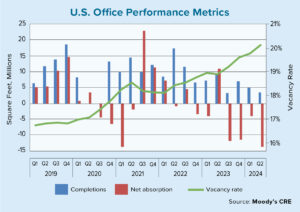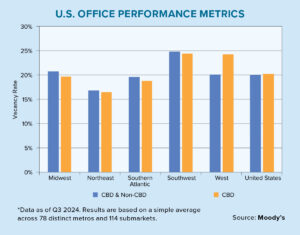Last year was going to be viewed as a solid but unspectacular year for commercial real estate. By fourth-quarter 2019, the fortunes of the industry were beginning to turn. Deal volume and commercial-asset prices had begun to falter after a decade of strong growth.
Then COVID-19 struck and everything suddenly changed. Who would have known that, in a few short months, we’d be referring to last year as the good old days?
The COVID-19 pandemic wreaked havoc around the globe, with devastating consequences for the U.S. economy. As most of the country was sheltering in place, entire industries were virtually shut down overnight. Sports and entertainment, restaurants, travel and lodging, and thousands of businesses deemed nonessential by state governments were ordered to close in an effort to flatten the curve and minimize the spread of the virus.
Although $350 billion of the federal stimulus package passed in March 2020 was dedicated to new small-business loans — which were intended to help business owners survive until the pandemic was under control — the commercial real estate market was largely left to fend for itself. And every sector of the market was affected.
Offices were vacated as millions of employees were instructed to work from home. Retail outlets across the country were shuttered. Hotels in certain hubs and popular tourism spots reported year-over-year occupancy declines of more than 90%. Apartment leasing slowed to a crawl as landlords speculated whether their tenants would be able to pay rent. Senior housing — home to the population most vulnerable to the coronavirus — was under extreme duress. Healthcare facilities stretched to the breaking point. And warehousing and distribution centers struggled to meet the overwhelming demand for product delivery from housebound shoppers.
Needless to say, all of this has thrown the commercial real estate market into chaos. Although sales transactions and development deals haven’t completely stopped, they’ve slowed down dramatically. Financing new deals has become more difficult as the industry tries to forecast how deep the recession will be. Commercial mortgage professionals also are left guessing as to how rapidly the economy will recover, how many businesses will survive the downturn, how many people will have jobs waiting for them at the end of the crisis and how soon consumers will feel confident enough to start spending money again.
Without answers to these questions, it’s difficult to determine whether the market will suffer the kind of meltdown it experienced in 2008 (or worse), or if it will rebound in reasonably good shape. There likely will be, however, winners and losers that emerge in the post-pandemic period.
Get a FREE subscription to Scotsman Guide Magazine
The Premier Resource for Residential Mortgage Originators
Quick recovery
The industrial-property sector seems most likely to come out ahead after COVID-19 has run its course. First, shelter-in-place orders have fast-tracked the country’s already-growing tendency to shop online. As the volume of orders increased, warehousing and distribution networks were overwhelmed, and shipping times lagged. It wouldn’t be surprising to see Amazon and other major online retailers invest heavily in distribution hubs across the country in their quest to deliver goods to consumers almost instantaneously.
Second, a more distributed workforce means that computing power also is likely to become more decentralized, likely leading to the creation of more cloud-computing facilities. Finally, in light of the difficulty the country has had in producing personal protective equipment, ventilators and other materials during the crisis, manufacturing capabilities will likely become more of a focus for federal and state governments. All three of these trends bode well for growth in the industrial sector.
The apartment sector will probably suffer in the immediate aftermath of the pandemic, but it is well-positioned to rebound quickly. Many of the hardest-hit industries are comprised of hourly workers who are more likely to be renters than homeowners. With little to no savings, many tenants will undoubtedly fail to make rent payments. This, coupled with government restrictions on evictions, will cause financial stress for many landlords. But the multifamily-housing sector also is likely to recover fairly quickly, and it is quite possible that multifamily will see more growth than previously forecast.
Part of this is simply due to demographics. U.S. household formation is likely to surpass 1 million new units again in 2020 and there simply aren’t enough homes for sale to accommodate that kind of growth. Another part of it is a byproduct of the pandemic. Many renters who had planned to purchase a home will probably have to reset their homebuying clocks and spend time rebuilding their finances after being out of work during shelter-in-place restrictions. Demand for rental-housing units should be poised for growth over the next few years.
The apartment sector will probably suffer in the immediate aftermath of the pandemic, but it is well-positioned to rebound quickly.
Slow bounce back
Of all commercial real estate industry segments, long-term changes due to COVID-19 might affect the office sector more than most. Many companies will likely be surprised by how productive their employees can be while working from home. For many of these companies, their facilities usually trail only employee compensation in terms of operating costs. If there’s a way to dramatically reduce these overhead costs without a commensurate drop-off in productivity, companies will almost certainly consider reducing or eliminating their office space.
If a completely remote workforce isn’t practical, business owners might look at a distributed workforce comprised of smaller offices in less expensive metros. This would represent a significant change to the current model of highly centralized offices in major metropolitan areas. And we also might see office configurations change dramatically to provide more social-distancing capabilities and help to prevent the spread of future diseases. So, the size, location and the structure of tomorrow’s office properties could well change due to the COVID-19 pandemic.
In the short term, the hotel sector is probably going to suffer the most damage. Industry leader Marriott International reported that North American occupancy rates were running at about 10% this past March, 870 hotels had temporarily closed and that its continental revenue per available room (RevPAR) expectation for March 2020 would decline by nearly 60% on a year-over-year basis.
The outlook for travel is equally bleak, with airport traffic slowing down to a crawl. Both American Airlines and United Airlines announced plans to cut the majority of their domestic and international flights in the near term. It also doesn’t seem likely that many people will be anxious to travel in large numbers until the pandemic has passed or there’s an effective vaccine available. So, the hospitality sector will likely be among the slowest to recover — and among the most likely to see a rise in loan defaults — particularly among smaller, thinly capitalized hotel owners.
In the long run, however, retail might be the sector that suffers the most. Partly due to the loss of sales to e-commerce, this sector was already struggling prior to the COVID-19 outbreak, with vacant suburban shopping malls and big-box retailers such as Macy’s, Sears and J.C. Penney shuttering stores across the country.
The retail sector also is notoriously vulnerable to swings in consumer behavior, which could be problematic at a time when consumer confidence has fallen dramatically. Typical shoppers may be disinclined to venture out amongst crowds until they are sure the threat of infection has been eliminated. The weakness of retailers, coupled with the accelerated growth of online shopping, does not bode well for this sector.
New opportunities
It’s worth noting that the demise of the retail sector has been predicted before with the so-called “retail apocalypse.” Although it’s unlikely that we’ll see much in the way of new retail construction, it’s likely that we’ll see developers continue to find creative ways to repurpose existing facilities into multiuse complexes – combining shopping with food services, offices, entertainment, health and fitness centers, and even apartments. This was already happening and may now accelerate.
The pandemic also has brought to light other needs that could present opportunities for investors, developers and the commercial mortgage industry. There’s clearly a need for upgraded senior-living facilities. Some of the most severe COVID-19 problems happened in nursing homes in Washington state and New Jersey. Other health care facilities, especially hospitals in large cities, were stretched to their limits trying to treat a huge influx of seriously ill patients. And the country’s dramatic lack of flexible manufacturing facilities made producing and distributing the products needed to combat the virus incredibly difficult.
Although there’s nothing good about a global pandemic, COVID-19 and our country’s response to it have certainly highlighted the challenges that need to be addressed before we’re faced with the next health crisis. This could prompt a change in direction for the next generation of leaders in the commercial real estate and mortgage industries. •
Author
-

Rick Sharga is the executive vice president of market intelligence at Attom Data Solutions. Sharga has more than 20 years of experience in the real estate and mortgage industries, having previously served in executive roles for RealtyTrac, Carrington Mortgage Holdings, TenX and Auction.com. He is one of the country’s most frequently quoted sources on real estate, mortgage and foreclosure trends. Sharga is a founding member of the Five Star Institute’s National Mortgage Servicing Association and is on the board of directors for the National Association of Default Professionals. Learn more about Attom Data Solutions at attomdata.com.
View all posts






